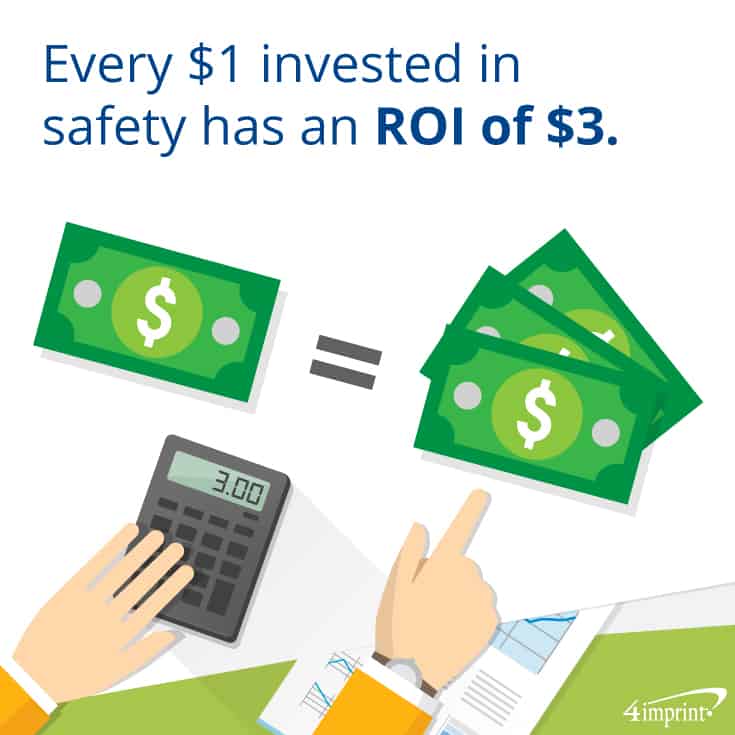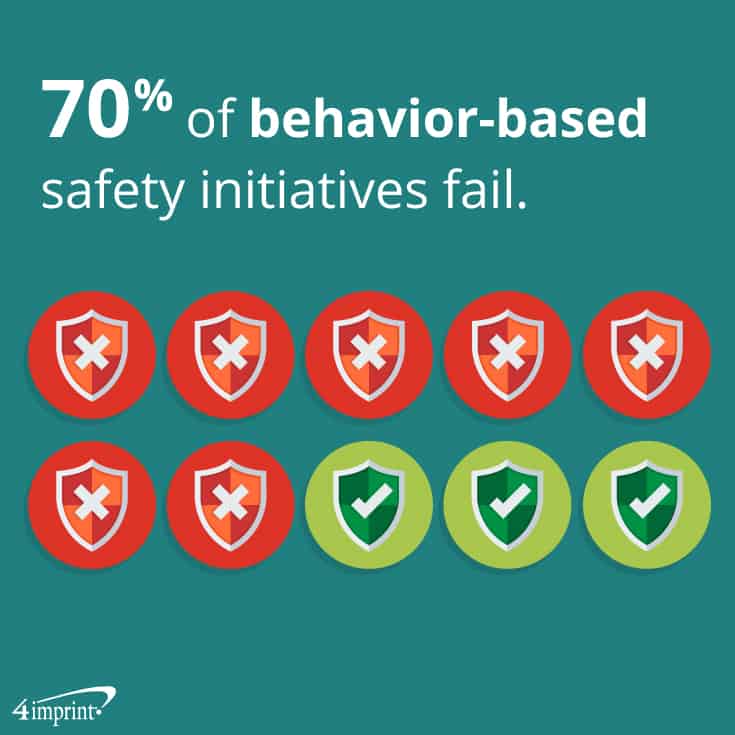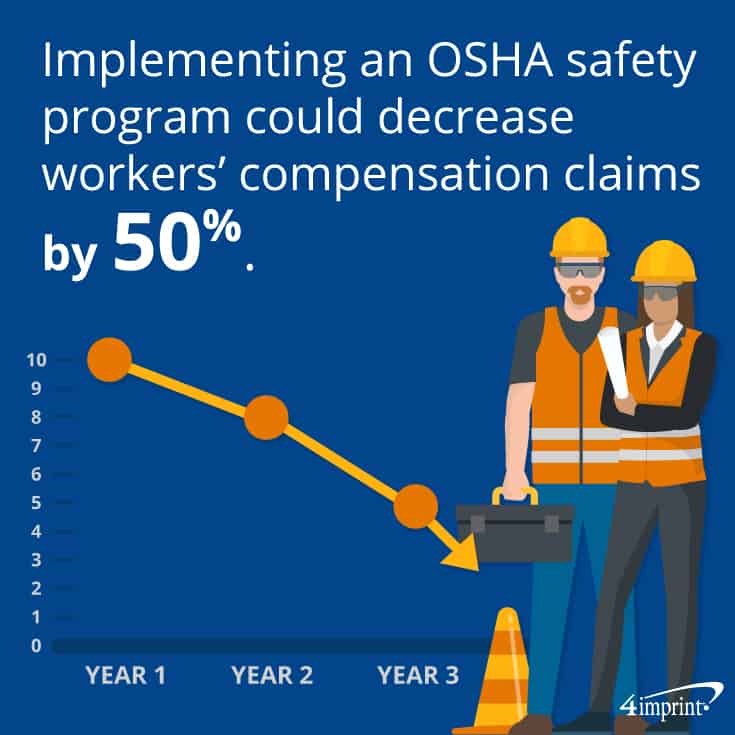When your company puts safety first, it’s a big win for everyone. With every workplace safety tip, safety incentive gift and group training session, you’ll make your workplace better by protecting staff and boosting your bottom line.
In this edition of our Blue Papers®, we take a closer look at the benefits of a strong safety program, ways to get your employees on board, and how to avoid the pitfalls that can occur when you’re creating or building a program.

The value of safety
It may go without saying that keeping your team safe is an excellent reason to implement or update a safety program. But, the value of safety is more extensive than many people may realize. Studies show that for every dollar invested in safety, there’s a return on investment of three dollars.
Benefits of a strong safety program include:
- Better products and services: When a company cares about its employees, the employees care more about their work.
- Improved reputation: Being known as a safe company improves your standing in the community and makes hiring easier.
- Higher employee retention: Employees who feel safe on the job are less likely to look for another position.
- Fewer injuries: For a company, injuries can result in productivity loss, administrative expenses and higher insurance costs.
When to review your safety program
While many organizations choose to review their safety program at the start or end of the year, there are other times to consider. Take a look at the program when you’re:
- Adding a new line of business
- Changing your safety budget
- Installing or operating new equipment
- Updating your program due to changes in federal, state or local safety requirements
- Adding several new employees
- Making immediate safety improvements due to recent events
- Adding staff to the safety department
Getting employees on board with your safety program
Once you’ve figured out when and how you are going to establish safe practices, find ways to encourage employee participation. The Occupational Safety and Health Administration (OSHA) offers these tips:
Give staff access to safety information
Share critical safety information with your staff that allows them to make informed decisions. Make them aware of:
- Safety data sheets
- Data about injury and illness
- Environmental exposure monitoring results
- Chemical and equipment manufacturer safety recommendations
- Workplace inspection reports
- Incident investigation reports
All reports should have redacted personal or sensitive information
Encourage workers to report safety and health concerns
Encouraging workers to report potential issues immediately can stop problems before they start. To boost this behavior:
- Make sure employees know the process for reporting concerns or suggestions.
- Provide feedback on how the suggestions or concerns are being addressed.
- Remind workers that staff will not be retaliated against for reporting problems.
- Empower staff to stop working if conditions aren’t safe.
- Involve employees in creating solutions.
Remove barriers to participation
Be sure there are no language or cultural barriers preventing employees from fully involving themselves in the program. And make safety training and discussion part of the normal workday so that all staff members can participate.
Because it’s critical that everyone stays up to date, be sure training isn’t used as a reward or punishment. Treating mistakes and incidents as learning opportunities makes it easier to foster a culture of improvement.
Involve employees in all aspects of the program
Encourage employees not only to report possible problems but to participate in every aspect of the safety program. Employees can help train their fellow staff members, create program goals and determine what information should be included in safety materials.
Potential barriers to safety success
When creating or improving a safety program, there are common challenges that prevent them from launching effectively. In fact, 70% of behavior-based safety initiatives fail, according to an EHS Today article.

Failing to do these things could create barriers to safety program success:
Sharing accountability
Making safety concerns the focus of a few department members can turn safety from everyone’s problem into “someone else’s” problem. Make a big impact by giving every employee the power to point out possible safety violations or share ideas that might make your workplace safer.
Explaining the “why”
Although employees may have considered how safety affects their wellbeing, they may not be aware of an accident’s implications. Take the time to explain the longer-reaching consequences of accidents, like:
- An injured person may not be able to work, which means the company may have to pay for a temporary or permanent hire.
- Injuries may result in missed deadlines that can lead to broken contracts and possible loss of business long-term.
- Accidents can also raise the cost of insurance, lowering the company’s bottom line, resulting in less profit sharing.
Help staff realize how much a safety program can help prevent these issues. According to one OSHA study, implementing a safety program could decrease workers’ compensation claims by more than 50% and lower the cost per claim by 80% (PDF).

Making safety a strategic initiative
If a CEO or high-level leader doesn’t seem to make safety a priority, staff may feel that the program isn’t important to the company. When leaders take an interest in safety, it shows employees and customers that the company values their health and wellbeing.
It also ensures that the company is:
- Implementing and operating new or updated programs
- Monitoring and evaluating safety performance
- Addressing program shortcomings
Changing company culture
When a new safety program is put into place, companies sometimes forget to remember that the “end” result isn’t really the end—programs should provide continuous improvement.
While monthly safety training and reviews are valuable, help employees understand that “better every day” is the goal. This prevents staff members from going through the motions of safety or thinking that the program has an end date.
One customer found a way to encourage everybody to come up with new ways to keep everyone safe.
“The company is very big on safety,” said a staff member. “In every way we can, we try to make sure people are looking for new ways to be safe and passing those tips along to other employees.”
The company decided to have fun when encouraging staff to submit safety tips with a safety incentive gift—they offered a stainless steel mug to anyone who shared one. “It was a big hit,” the staff member said. “After the first few mugs were handed out, everyone was asking how they could get one.”
Using safety incentive gifts as positive reinforcement
Many safety programs rely on telling staff when they are doing something incorrectly, rather than praising them or rewarding them for doing something right.
Because dangerous behaviors can yield “good” results—for example, a hazardous shortcut might speed up production—giving immediate positive reinforcement for safe behavior is necessary for staff to build better, safer habits.
Wilsonart goes out of its way to recognize the positive short-term and long-term safety choices staff makes. “We do weekly safety contacts, letting employees know positive things they do on the safety side every week,” said EHS Technician Daniel Bradley.
They also have a system in place to create systemic improvements—and a strong process for keeping up with it.
“Every six months, our teams have to score themselves on 10 categories, and if they exceed expectations on that score, they receive a gift at the end of the year,” Bradley said.
Past safety incentive gifts for employees include a Jerzees® NuBlend ¼-Zip Sweatshirt, a Jerzees Dri-Power Tri-Blend T-Shirt for men and women, a Crossland® Fleece Jacket for women and men and an Arctic Zone® Titan Deep Freeze Backpack Cooler. Because the gifts get so much use, they also remind employees to keep improving safety so they can get next year’s gift.
And their hard work is paying off. The company has lowered its incident rate over the last four years, from 2.57% to 1.42%.
It should be noted that to be OSHA compliant, prizes cannot be awarded for inadvertently or purposefully discouraging employees from reporting injury or illness. OSHA suggests offering rewards or praise for:
- Providing safety suggestions
- Guiding a co-worker or new employee in a safety task
- Participating in a safety committee
Safety is an employee’s best defense
Strong safety initiatives help to build better businesses. By removing barriers to participation and rewarding smart choices with safety incentive gifts, you can keep your most valuable asset—your staff—safe, not to mention your bottom line. For additional safety tips and giveaway ideas, read our safety giveaways post.

